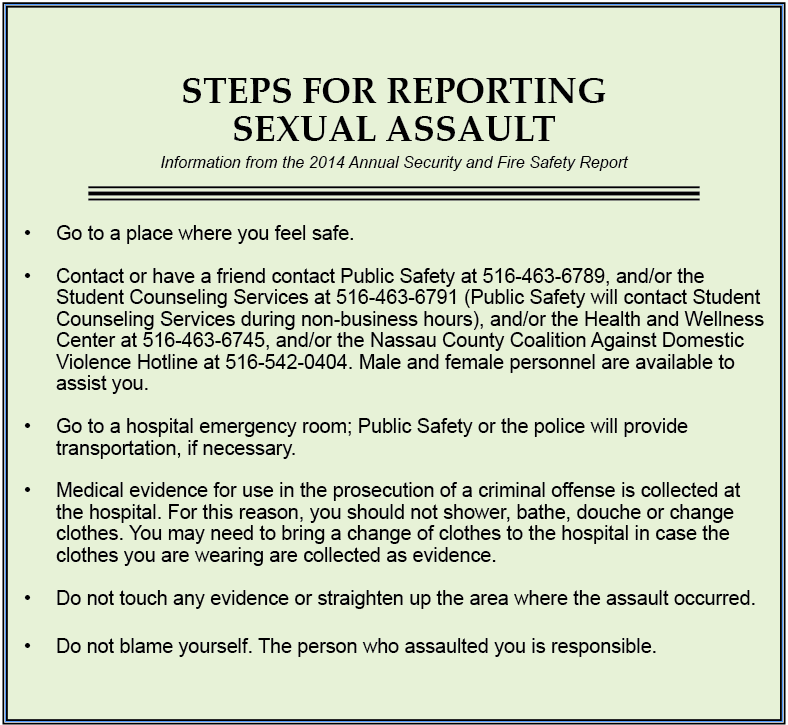By Elizabeth Merino ARTS AND ENTERTAINMENT EDITOR
The “red zone” is a vulnerable and dangerous time period for sexual assaults involving the newest incoming class. It can last anywhere from the first six weeks of school, stretching from Labor Day to Thanksgiving in other instances.
More than 50 percent of sexual assaults occur between August and November, according to the 2007 Campus Sexual Assault Study.
When 15 Hofstra freshmen were asked about the “red zone,” none had heard of it or been educated on it.
“The NFL red zone?” asked freshman Cristian Scobell.
Freshman Elaina Sullivan echoed Scobell’s confusion. “I’ve never heard of the red zone… they just told us to be safe… like staying in groups with people,” she said.

According to Business Insider, a Journal of American College Health study found that there is “substantial” support for the red zone. According to the study, more reports of unwanted sexual advances are made during the earlier part of the academic year, especially towards freshmen.
Two freshmen stated they had already heard of or have been in contact with fellow freshmen that had been assaulted.
“I know cases of it,” said freshman Trey Jackson. “They weren’t fully aware of what happened though. They haven’t talked about it again.”
According to the United States Centers for Disease Control and Prevention, “in a study of undergraduate women, 19 percent experienced attempted or completed sexual assault since entering college.”
If this federal government statistic was applied to Hofstra’s 2013 fall semester student intake, approximately 689 undergraduate Hofstra women will be assaulted during their four years here.
“I haven’t seen anything while I’ve been out,” said freshman McKenzie Smith. “I’ve heard instances from people, like attempted sexual assault. They went to the Wellness Center, and it did help. I think they would have been better off to call [Public Safety] that night, but they waited until the next day.”
Hofstra has instituted resources for sexual assault victims, but it is unclear if students know when, where and how they can be available.
“Hofstra is certainly aware of risks for college students and we care very much about the community and healthy relationships,” said Assistant Vice President for Student Affairs, Jean Peden Christodoulou.
Hofstra has recently revamped their sexual assault policy, which can be found in the newly released 2014 Annual Security & Fire Safety Report.
“We want to both create an environment where campus is safe and also [create] an environment where people will report it and feel comfortable doing so,” said Christodoulou.
According to the report, “sexual misconduct consists of non-consensual sexual contact, non-consensual sexual intercourse and sexual exploitation.”
All three are defined in the report, as well as what consent is, isn’t and can be: “consent means the active, knowing and voluntary agreement to engage in sexual activity without coercion or fear or threat of harm.”
“So these kinds of things are covered in RA training. Student conduct issues are spoken about including issues that first years go through,” said Christodoulou. “We actually just held in-service training about the new policy, what to look for… we are always open to suggestions too, though.”
At freshman orientation this past summer, all incoming students were required to watch a skit developed by orientation leaders, according to Christodoulou. This video used the euphemism of borrowing a student’s cellphone to relate to sexual relations. Although you may have used someone’s “phone” before, it does not mean that you are entitled to use it again, that you don’t have to ask to use it first or that you can take it by force. If you see someone take someone’s cellphone or harass them for it, you should step in and say something.
“We are trying to help make Hofstra be a place where students look out for each other, and articulate their rights,” said Christodoulou.
Some freshmen believe that the resources are available to them, but are unsure of their ultimate use. Others said they would call Public Safety, 911 or tell their RA if they or a friend was assaulted. Many students were confused as to the exact protocol that could be followed.
“They talked about it at orientation…but it would help if you had a boy RA and a girl RA. In my house we have no girl RA, so I have no choice but to talk to a boy,” said freshman Virginia Kemp.
“I know you can call Public Safety… and there’s a counseling center but I don’t know where it is,” said freshman Ana Bencatel.
Others feel as if the same mantras of “being safe” and “protecting yourself” have begun to fall on deaf ears.
“Even if the RA’s say something it’s not like we are going to listen, we listen to people all the time, another 30-minute meeting is just another thing to sit through,” said freshman Jeff Lin.
Freshman Adam Artell shared some of Lin’s opinion.
“It’s more like if you haven’t seen or heard of an experience you aren’t particularly worried,” Artell said.
Hofstra is still only in the beginning stages of the red zone.
According to Christodoulou, events are being planned, meetings held and student-administrator communication opened, to ensure that sexual assault violence and awareness are brought to light.
Still, some feel as though Hofstra may be lacking in its response.
“For the most part, we have been encouraged to seek out resources, but that doesn’t mean, I think, that everyone has the courage to use them,” said freshman Matt Mogavero.


